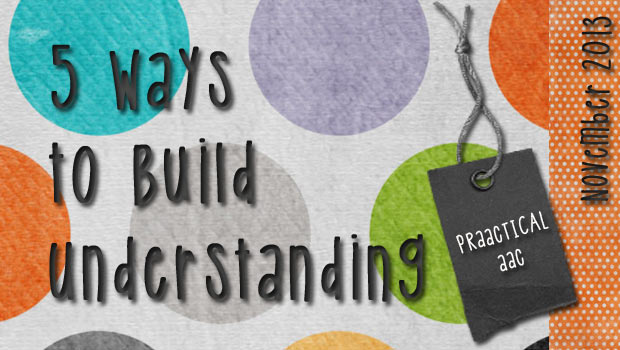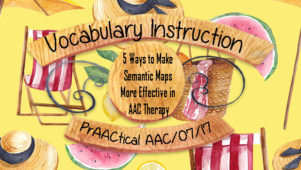5 Ways to Build Understanding

Teaching language can be a sticky business. The concepts can be quite abstract, and that’s a challenge for many AAC learners. It can take some real thought to figure out how to simplify complexity. Beyond that, we have to teach in a way that helps learners retain the new information. Here are some of the things we think about when we’re running the our mental checklist of teaching options.
1. Graphic Organizers: There are so many ways to use graphic organizers to help simplify complex concepts. Use them to show relationships  between things, sequences, and component parts.
between things, sequences, and component parts.
2. Use a Story: Social narratives are somewhat like social stories, but don’t adhere to the same strict design parameters as a true social story. The TASN project in Kansas has almost 150 of them on a variety of topics on their website. You can check them out here. Most are in .doc, .pdf, or .ppt formats, though there are also many Boardmaker files, too.
3. Redundancy: Say it, show it, do it. Say it a different way, show it in a different context, do it with different materials. Repetition with variety makes learning last.
4. Contingency Maps: We’re most familiar with using contingency maps as a way to support individuals who have challenging behavior. They can also serve as a clear way to represent courses of action for other things, such as ignoring people when they talk to you or using up all your week’s treat money on Monday. Representing the consequences of each option can be very helpful to people learning to make good choices for themselves.
5. Break it Down and Spread it Out: If the concept is complex or the process is long, don’t feel like you have to teach it all at once. Dissect it and teach a bit at a time. This works really well with things that have a built-in sequence, like sending an email or posting to Facebook. It can work well in semantic instruction, too. For example, we may first teach the main meaning of a word, then go back later to teach the alternate forms and meanings for that word. Often, teaching it in chunks leads to better outcomes, so don’t feel compelled to teach the whole thing at once.
Do you have tried-and-true strategies for building comprehension of new, abstract, or complex ideas? We’d love to hear about them.
Filed under: PrAACtical Thinking
Tagged With: comprehension, contingency map, Graphic Organizers, social narrative, understanding
This post was written by Carole Zangari




